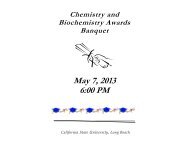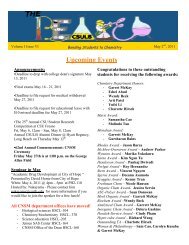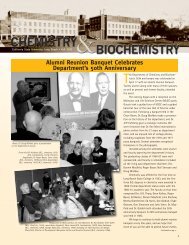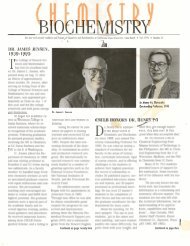2011 - California State University, Long Beach Department of ...
2011 - California State University, Long Beach Department of ...
2011 - California State University, Long Beach Department of ...
You also want an ePaper? Increase the reach of your titles
YUMPU automatically turns print PDFs into web optimized ePapers that Google loves.
1970<br />
George Mast (B.S., chemistry) writes, “I was<br />
fortunate to do independent research at CSULB<br />
under Dr. Nail Senozan. I received my M.Sc. and<br />
Ph.D. from Brown <strong>University</strong>. While doing<br />
postdoctoral research with Dr. Jack Decius at<br />
Oregon <strong>State</strong>, I wrote 140 letters trying to get a<br />
job. I received 114 absolute rejections and two<br />
nibbles. I received an <strong>of</strong>fer to teach for one year<br />
at Furman <strong>University</strong>. Because <strong>of</strong> my lack <strong>of</strong><br />
success (which Dr. Senozan attributed to the end<br />
<strong>of</strong> the Apollo program), I looked over my skills and<br />
decided to pursue a scientific programming job.<br />
My programming skills started at Brown when I<br />
had to teach an undergraduate chemistry student<br />
to program in FORTRAN. During my time at<br />
Brown, I gained additional programming skills,<br />
becoming a pretty good programmer for a<br />
chemist. Subsequently, at Oregon <strong>State</strong> during<br />
my post doc, I added to my programming skills<br />
and started performing system administration<br />
duties on a PDP-10 mini-computer. I then moved<br />
to Edmonton, Alberta, Canada as a postdoc under<br />
John Bertie, where I assisted in some computer<br />
calculations for a journal article. While there, I<br />
came back to Southern <strong>California</strong> to look for a<br />
programming job, getting two <strong>of</strong>fers in two<br />
weeks <strong>of</strong> searching. I joined a small computer<br />
s<strong>of</strong>tware company, called Intermetrics, which had<br />
developed the HAL language used for the space<br />
shuttle’s flight computers. I spent 24 years as a<br />
programmer/systems administrator/network<br />
administrator. I retired because <strong>of</strong> health reasons.”<br />
1977<br />
Ray Calloway (B.S., chemistry), formerly <strong>of</strong><br />
Aerospace Corporation, is now happily retired.<br />
His hobbies are golf and woodcarving.<br />
Frederick “Fritz” C<strong>of</strong>fman (B.S., chemistry)<br />
received his Ph.D. at UC Riverside in 1986,<br />
working on hexamer formation by insulin, and<br />
then served as a postdoc studying the mechanism<br />
<strong>of</strong> tumor necrosis factor (TNF). He was a faculty<br />
member at Hahnemann <strong>University</strong> Medical<br />
School in Philadelphia, Penn. Fritz is currently<br />
associate pr<strong>of</strong>essor in the <strong>Department</strong> <strong>of</strong><br />
Pathology at the New Jersey Medical School. He<br />
does research in several areas related to cancer,<br />
including the role <strong>of</strong> the chitinase family protein<br />
CHI3L1 (or YKL-40) in tumor survival/progression/<br />
angiogenesis, the enhancement <strong>of</strong> TNF-mediated<br />
cytotoxicity by certain DNA topoisomerase II<br />
inhibitors, the initiation <strong>of</strong> DNA replication in<br />
human leukemic cells from the origin region<br />
20<br />
Alumni News<br />
within the ribosomal RNA gene, and biophysical<br />
pr<strong>of</strong>iling <strong>of</strong> tumors using optical devices related<br />
to plasmon resonance, impedance measurements<br />
and laser Raman instruments. He also teaches<br />
and is the director <strong>of</strong> the graduate core course,<br />
“Introduction to Medical Science,” which “covers<br />
an impossible number <strong>of</strong> complex topics in the<br />
time allotted.”<br />
1978<br />
Betty Burri (M.S., biochemistry) writes, “I got my<br />
Ph.D. at UC San Diego in 1982. For the past 25<br />
years, I have been a research chemist at the<br />
Western Human Nutrition Research Center, U.S.<br />
<strong>Department</strong> <strong>of</strong> Agriculture, in Davis, Calif. I am<br />
also adjunct pr<strong>of</strong>essor at the Nutrition<br />
<strong>Department</strong> and a member <strong>of</strong> the Food Science<br />
and Technology group at UC Davis. My major<br />
research focuses now are: the functions and<br />
metabolism <strong>of</strong> beta-cryptoxanthin, a member <strong>of</strong><br />
the carotenoid family that forms vitamin A (like<br />
the better-known beta-carotene); and<br />
developing new food-based interventions to<br />
increase vitamin A status. Vitamin A deficiency<br />
blinds about half a million children each year and<br />
causes millions <strong>of</strong> deaths during childhood in<br />
southern Asia and sub-Saharan Africa. I am<br />
combining those two interests in a research<br />
project that feeds mandarin oranges (a great<br />
source <strong>of</strong> beta-cryptoxanthin) or sweet potatoes<br />
(an even better source <strong>of</strong> beta-carotene) to<br />
lactating Bangladeshi women with low vitamin A<br />
to improve their vitamin A status. Another project<br />
tests the efficacy <strong>of</strong> cassava, a staple crop in<br />
Africa and South America, bi<strong>of</strong>ortified with betacarotene<br />
to increase vitamin A. We joke that we<br />
have a license to import plants from Colombia<br />
and a fully equipped laboratory—and what do we<br />
use them for? Cassava. Oh well, you become a<br />
scientist because it is interesting, not to get rich.”<br />
Chris Pritsos (M.S., biochemistry program,<br />
1975-78) writes, “Upon leaving CSULB, I<br />
entered the Ph.D. program in biochemistry at<br />
the <strong>University</strong> <strong>of</strong> Nevada, Reno (UNR), where I<br />
earned my doctorate in 1982. My dissertation<br />
focused on the mechanism <strong>of</strong> action <strong>of</strong> quinone<br />
anticancer agents, particularly focusing on<br />
their redox interactions with mitochondria. I<br />
continued my study <strong>of</strong> cancer chemotherapy<br />
during my postdoctoral work at the Yale <strong>University</strong><br />
Comprehensive Cancer Center. In 1985,<br />
I was recruited back to UNR as a research<br />
assistant pr<strong>of</strong>essor in the Biochemistry <strong>Department</strong>.<br />
In 1988, I was asked to help form a new<br />
<strong>Department</strong> <strong>of</strong> Nutrition, where I have been<br />
ever since. I have served as department chair<br />
since 2000. Over the years, I have continued<br />
my work in the cancer chemotherapy area,<br />
looking at activation pathways and alternative<br />
targets for these compounds. I have also<br />
expanded my research interests to include the<br />
toxicity <strong>of</strong> exposure to environmental pollutants.<br />
I have conducted several studies related<br />
to the health effects <strong>of</strong> exposure to environmental<br />
tobacco smoke, particularly as it pertains<br />
to casino workers in Nevada. My newest<br />
challenge is in serving as the chair <strong>of</strong> a newly<br />
organized <strong>Department</strong> <strong>of</strong> Agriculture, Nutrition<br />
and Veterinary Sciences, which joins faculty<br />
from several departments. I remain married (29<br />
years) to my wife, Karen, who I met in grad<br />
school at UNR, and we have two children,<br />
Jenna (law school, <strong>University</strong> <strong>of</strong> Wisconsin)<br />
and Evan (junior, Occidental College).”<br />
Martin Schroeder (M.S., biochemistry),<br />
executive vice president and managing director<br />
<strong>of</strong> the Emmes Group, Inc., a strategic business<br />
consulting firm, was appointed to the board <strong>of</strong><br />
directors at Genesis Biopharma, Inc.<br />
1980<br />
Brian Imai (M.S., biochemistry program, 1977-80)<br />
received his Ph.D., working on the structural<br />
biology <strong>of</strong> chromatin in Dr. Morton Bradbury’s lab<br />
at UC Davis, and continued for several years as a<br />
postdoc under Bradbury at Los Alamos National<br />
Laboratory, where he “along the way ended up<br />
getting married.” He did a brief postdoc at UC<br />
Santa Barbara, working on the structure <strong>of</strong> reverse<br />
transcriptase. He writes, “This was cut short when<br />
I was <strong>of</strong>fered a job in the protein/DNA core facility<br />
at Rockefeller <strong>University</strong> to be in charge <strong>of</strong> peptide<br />
synthesis. After a couple <strong>of</strong> years, I became<br />
director <strong>of</strong> the facility and oversaw the operations<br />
<strong>of</strong> the DNA sequencing, protein sequencing,<br />
protein analysis and peptide synthesis units. After<br />
several more years, the facility was restructured<br />
into a proteomics facility, and I became associate<br />
director. I spent a total <strong>of</strong> nine years there, and<br />
along the way, my wife and I had a son. Then six<br />
years ago, I had an opportunity to come to the<br />
<strong>University</strong> <strong>of</strong> Illinois’s Carver Biotechnology<br />
Center’s Protein Sciences Facility as a proteomics<br />
bioinformatics specialist. Trying to stay on top <strong>of</strong><br />
the s<strong>of</strong>tware that we use to analyze the data is<br />
the primary component <strong>of</strong> my job, but I am also<br />
involved in 2-D gel analysis (DIGE), running and<br />
maintaining our LC-MS/MS mass spectrometers<br />
Continued


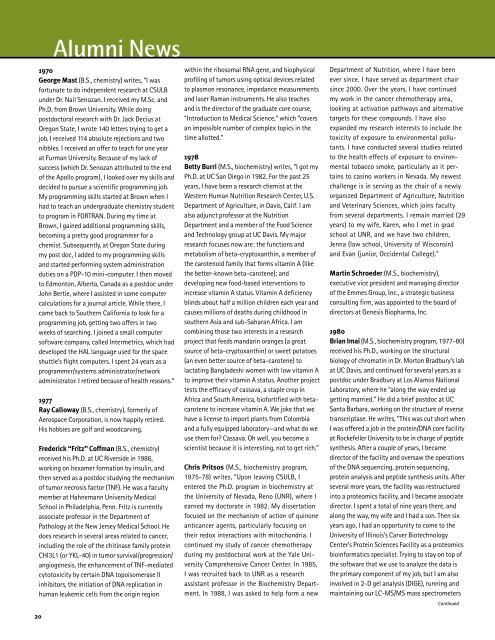
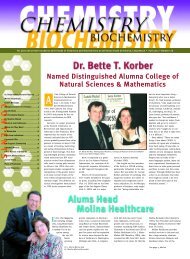
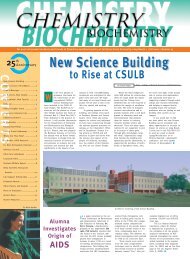
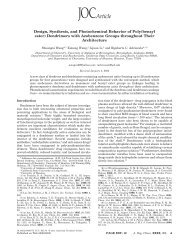
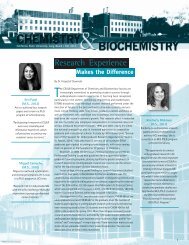
![Volume 4, Issue 3 [November 2012 pdf] - California State University ...](https://img.yumpu.com/34605825/1/190x245/volume-4-issue-3-november-2012-pdf-california-state-university-.jpg?quality=85)
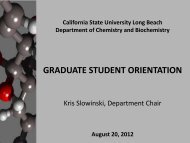
![Volume 5, Issue 2 [April 2013 pdf] - California State University, Long ...](https://img.yumpu.com/33273195/1/190x245/volume-5-issue-2-april-2013-pdf-california-state-university-long-.jpg?quality=85)
